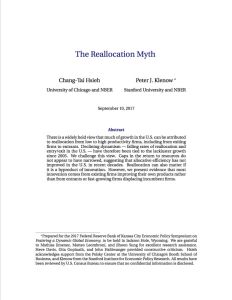加入 getAbstract 阅读摘要

加入 getAbstract 阅读摘要
Chang-Tai Hsieh and Peter J. Klenow
The Reallocation Myth
Fed Kansas City, 2017
看看什么内容?
Slow growth in US GDP since 2006 may be tied to the economy’s “allocative efficiency.”
Recommendation
The term “creative destruction” describes the sometimes painful shift of capital, labor and assets to higher levels of dynamism and productivity. This reallocation across an economy augurs stronger long-run growth and increasingly vibrant activity, particularly if new companies displace legacy firms. Some blame sluggish US growth since 2006 on a lack of creative destruction. But economists Chang-Tai Hsieh and Peter J. Klenow disagree. Their technically complex report on the ebb and flow of an economy will interest researchers and analysts.
Summary
About the Authors
Chang-Tai Hsieh is an economics professor at the University of Chicago Booth School of Business. Peter J. Klenow is a professor of economic policy at Stanford University.

















Comment on this summary